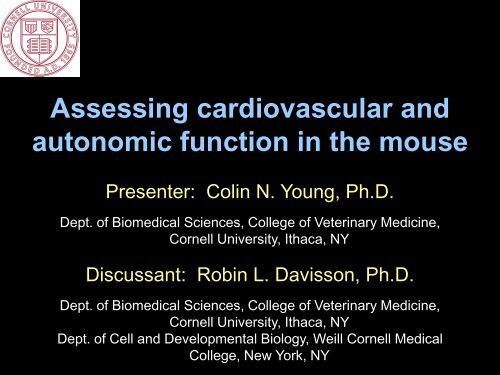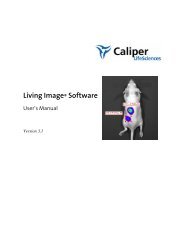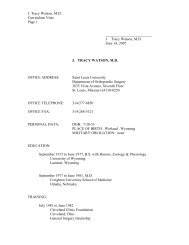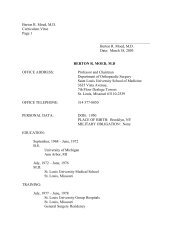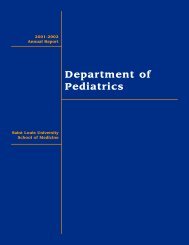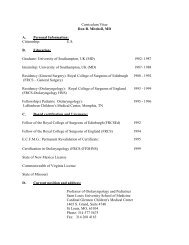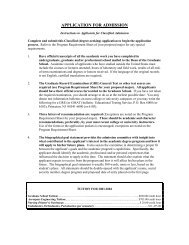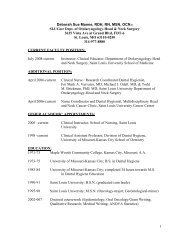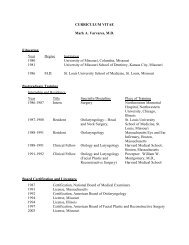Assessing cardiovascular and autonomic function in the mouse
Assessing cardiovascular and autonomic function in the mouse
Assessing cardiovascular and autonomic function in the mouse
Create successful ePaper yourself
Turn your PDF publications into a flip-book with our unique Google optimized e-Paper software.
<strong>Assess<strong>in</strong>g</strong> <strong>cardiovascular</strong> <strong>and</strong><br />
<strong>autonomic</strong> <strong>function</strong> <strong>in</strong> <strong>the</strong> <strong>mouse</strong><br />
Presenter: Col<strong>in</strong> N. Young, Ph.D.<br />
Dept. of Biomedical Sciences, College of Veter<strong>in</strong>ary Medic<strong>in</strong>e,<br />
Cornell University, Ithaca, NY<br />
Discussant: Rob<strong>in</strong> L. Davisson, Ph.D.<br />
Dept. of Biomedical Sciences, College of Veter<strong>in</strong>ary Medic<strong>in</strong>e,<br />
Cornell University, Ithaca, NY<br />
Dept. of Cell <strong>and</strong> Developmental Biology, Weill Cornell Medical<br />
College, New York, NY
Autonomic control of arterial blood pressure<br />
Blood Pressure<br />
The unique susceptibility of mice to<br />
genetic manipulation makes this<br />
species an attractive model to def<strong>in</strong>e<br />
<strong>the</strong> molecular <strong>and</strong> cellular<br />
mechanisms essential to<br />
neuro<strong>cardiovascular</strong> regulation<br />
Paraphrased from Ma et al, Cl<strong>in</strong> Exp Pharm Physiol 2003
How do we measure blood<br />
pressure <strong>in</strong> a <strong>mouse</strong>?
Indirect Method: Tail Cuff Plethysmography<br />
Sample Manufacturers:<br />
Restra<strong>in</strong>er Occlusion Cuff Sensor<br />
• Images from Kent Scientific Corp. (www.kentscientific.com)<br />
• Columbus Instruments (www.col<strong>in</strong>st.com)<br />
• Stoelt<strong>in</strong>g (www.stoelt<strong>in</strong>gco.com)<br />
• volume pressure<br />
• photoplethysmography<br />
• piezoplethysmography
Indirect Method: Tail Cuff Plethysmography<br />
Occlusion Cuff<br />
Pressure (mmHg)<br />
Tail Pulse (mV)<br />
PROS:<br />
• Fairly <strong>in</strong>expensive (
Direct Methods: Implanted arterial ca<strong>the</strong>ters & radiotelemetry<br />
Implanted arterial ca<strong>the</strong>ters<br />
• Fluid-filled ca<strong>the</strong>ter placed <strong>in</strong> a major artery (i.e. femoral)<br />
• Ca<strong>the</strong>ter exteriorized, connected to a pressure transducer,<br />
amplifier <strong>and</strong> record<strong>in</strong>g system<br />
PROS:<br />
• Can obta<strong>in</strong> long-term record<strong>in</strong>gs of BP<br />
• Fairly affordable<br />
CONS:<br />
• Requires surgical expertise<br />
• Ma<strong>in</strong>ta<strong>in</strong><strong>in</strong>g a patent arterial ca<strong>the</strong>ter for an extended period of<br />
time can be difficult<br />
Radiotelemetry
www.datasci.com<br />
Direct Methods: Radiotelemetry<br />
• Weight: 1.2 grams<br />
• Volume: 1.1 cc<br />
Magnetic<br />
Switch<br />
Pressure<br />
Transducer<br />
Fluid-filled ca<strong>the</strong>ter<br />
Electronics<br />
Antenna<br />
Sens<strong>in</strong>g region<br />
Battery<br />
(life: 1.5 months)
Thoracic aorta implantation of radiotelemeter<br />
Butz & Davisson, Physiol Gen. 2001<br />
Carotid Artery<br />
Thoracic Aorta<br />
Butz & Davisson,<br />
Physiol Gen. 2001
Direct Methods: Radiotelemetry data collection equipment<br />
Receiver
120<br />
Arterial<br />
Blood Pressure<br />
(mmHg)<br />
80<br />
Blood Pressure (mmHg)<br />
1 sec<br />
140<br />
120<br />
100<br />
80<br />
Direct Methods: Radiotelemetry<br />
Diurnal Record<strong>in</strong>gs<br />
<br />
140<br />
Time<br />
Recovery time is essential<br />
* p
Implant Radiotelemeters<br />
Radiotelemetry for chronic record<strong>in</strong>gs of BP<br />
7 days 3 days<br />
Recovery<br />
Osmotic pumps with Angiotens<strong>in</strong> II<br />
Basel<strong>in</strong>e Record<strong>in</strong>gs Chronic Record<strong>in</strong>g
Radiotelemetry for evaluat<strong>in</strong>g transgenic <strong>mouse</strong> models<br />
Transgenic mice carry<strong>in</strong>g both <strong>the</strong> HREN (R + ) <strong>and</strong> HAGT (A + )<br />
(Merrill et al, JCI 1996; Sigmund et al, Circ Res 1992; Yang et al, J Biol Chem 1994)<br />
Mean Arterial<br />
Blood Pressure (mmHg)<br />
160<br />
140<br />
120<br />
100<br />
<br />
Time<br />
R + A +<br />
Control
Radiotelemetry<br />
PROS<br />
• Long-term cont<strong>in</strong>uous record<strong>in</strong>gs of BP<br />
• Wireless<br />
• Can simultaneously obta<strong>in</strong> measures of:<br />
activity, biotentials (i.e. ECG) <strong>and</strong> body<br />
temperature<br />
Fluid-filled ca<strong>the</strong>ters<br />
Tail Cuff<br />
• Long-term cont<strong>in</strong>uous record<strong>in</strong>gs of BP<br />
• Fairly affordable<br />
• Useful for screen<strong>in</strong>g large numbers of<br />
animals<br />
• Cheap / easy<br />
CONS<br />
• Cost<br />
• Initial system to measure<br />
simultaneously <strong>in</strong> 32 mice<br />
~$100,000<br />
• Telemeter refurbishment<br />
~$400<br />
• Requires surgical expertise<br />
• Ma<strong>in</strong>ta<strong>in</strong><strong>in</strong>g patent l<strong>in</strong>e can be<br />
difficult<br />
• Requires surgical expertise<br />
• Very stressful on <strong>the</strong> <strong>mouse</strong><br />
• Only measures BP dur<strong>in</strong>g a few<br />
discrete cardiac cycles
Autonomic control<br />
Sympa<strong>the</strong>tic Parasympa<strong>the</strong>tic<br />
Heart Rate<br />
Blood Pressure
Indirect Methods to assess <strong>autonomic</strong> <strong>function</strong><br />
Plasma / ur<strong>in</strong>e estimates<br />
• Norep<strong>in</strong>ephr<strong>in</strong>e, ep<strong>in</strong>ephr<strong>in</strong>e or o<strong>the</strong>r metabolite measurements<br />
• Provides a “global” measure of sympa<strong>the</strong>tic nervous system activity<br />
Pharmacological<br />
• Measure hemodynamic responses to pharmacological blockade of<br />
parasympa<strong>the</strong>tic <strong>and</strong> sympa<strong>the</strong>tic tone (systemic or <strong>in</strong>traperitoneal)<br />
(+)<br />
Δ Heart Rate<br />
(-)<br />
Parasympa<strong>the</strong>tic<br />
Muscar<strong>in</strong>ic blocker<br />
(i.e. atrop<strong>in</strong>e)<br />
β-blocker<br />
(i.e. propranolol)<br />
Sympa<strong>the</strong>tic
Indirect Methods to assess <strong>autonomic</strong> <strong>function</strong><br />
Pharmacological (cont.)<br />
• Sympa<strong>the</strong>tic restra<strong>in</strong>t of <strong>the</strong> vasculature:<br />
• α-adrenergic blockade (i.e. prazos<strong>in</strong>)<br />
• Ganglionic blockade (i.e. hexamethonium)<br />
Mouse model of myocardial <strong>in</strong>farction<br />
• Ligation of left anterior descend<strong>in</strong>g artery<br />
or sham surgery<br />
• BP measured us<strong>in</strong>g radiotelemetry<br />
• Hexamethonium 5 mg/kg i.p.<br />
Sham MI<br />
Adapted from Infanger et al, Circ Res. 2010
Spontaneous fluctuations <strong>in</strong> <strong>cardiovascular</strong> parameters are<br />
related to <strong>autonomic</strong> <strong>function</strong><br />
Arterial Blood<br />
Pressure (mmHg)<br />
Very Low Frequency (VLF)<br />
Low Frequency (LF)<br />
High Frequency (HF)<br />
Cl<strong>in</strong>ical Significance<br />
• Increased blood pressure variability is l<strong>in</strong>ked to<br />
target organ damage<br />
• Decreased heart rate variability is related to<br />
<strong>cardiovascular</strong> mortality<br />
Rationale: Parasympa<strong>the</strong>tic <strong>and</strong> sympa<strong>the</strong>tic components contribute to<br />
variability <strong>in</strong> HR <strong>and</strong> BP at different frequencies
Indirect Methods to assess <strong>autonomic</strong> <strong>function</strong><br />
Power Spectral Analysis<br />
• Ma<strong>the</strong>matical <strong>in</strong>vestigation of <strong>the</strong> <strong>in</strong>dividual frequency ranges of blood<br />
pressure <strong>and</strong> heart rate (pulse <strong>in</strong>terval)<br />
• Custom written software: (Hemolab, www.haraldstauss.com)<br />
Which frequency b<strong>and</strong>s do <strong>the</strong><br />
sympa<strong>the</strong>tic & parasympa<strong>the</strong>tic<br />
nervous systems <strong>in</strong>fluence?
Power Spectral Analysis<br />
Heart Rate Variability<br />
Blood Pressure Variability – Sympa<strong>the</strong>tic Influence<br />
Sympa<strong>the</strong>tic Influence Parasympa<strong>the</strong>tic Influence<br />
Very Low Frequency (VLF)<br />
Low Frequency (LF)<br />
High Frequency (HF)
Catecholam<strong>in</strong>e<br />
measurements<br />
Heart Rate<br />
Circulat<strong>in</strong>g / Hormonal<br />
Factors<br />
Pharmacological / Ganglionic<br />
Blockade<br />
Blood Pressure<br />
Direct Record<strong>in</strong>gs of Nerve<br />
Activity<br />
Circulat<strong>in</strong>g catecholam<strong>in</strong>e levels are determ<strong>in</strong>ed by<br />
release, reuptake <strong>and</strong> degradation<br />
Local Vascular<br />
Influences<br />
Power Spectral Analysis
Direct record<strong>in</strong>gs of efferent nerve activity<br />
Sympa<strong>the</strong>tic record<strong>in</strong>gs<br />
• Detailed methodology by Dr. Sean Stocker <strong>in</strong> this workshop<br />
• Anes<strong>the</strong>tized record<strong>in</strong>gs of cardiac, lumbar, renal, brown fat <strong>and</strong> white<br />
fat sympa<strong>the</strong>tic nerve activity have been obta<strong>in</strong>ed <strong>in</strong> <strong>the</strong> <strong>mouse</strong>.<br />
mV<br />
K. Rahmouni, U. Iowa<br />
Basel<strong>in</strong>e renal sympa<strong>the</strong>tic<br />
nerve activity<br />
4 s<br />
Renal sympa<strong>the</strong>tic nerve activity follow<strong>in</strong>g<br />
<strong>in</strong>tracerebroventricular lept<strong>in</strong> (60ug)
• Easy to obta<strong>in</strong><br />
• Inexpensive<br />
PROS<br />
Plasma/Ur<strong>in</strong>e Measurements<br />
Pharmacological<br />
• Can be done <strong>in</strong> a conscious <strong>mouse</strong><br />
toge<strong>the</strong>r with <strong>the</strong> use of radiotelemetry<br />
• Fairly easy to perform<br />
Spectral Analysis<br />
• Can be done <strong>in</strong> a conscious <strong>mouse</strong><br />
toge<strong>the</strong>r with <strong>the</strong> use of radiotelemetry<br />
• Easy to perform with <strong>the</strong> appropriate<br />
software<br />
Sympa<strong>the</strong>tic Nerve Record<strong>in</strong>gs<br />
• Direct record<strong>in</strong>g of efferent sympa<strong>the</strong>tic<br />
nerve activity<br />
CONS / CAVEATS<br />
• “Global” measurement<br />
• “Global” measurement<br />
• Hemodynamic responses are also<br />
<strong>in</strong>fluenced by hormonal <strong>and</strong> local<br />
organ responsiveness<br />
• Hemodynamic responses are also<br />
<strong>in</strong>fluenced by hormonal <strong>and</strong> local<br />
organ responsiveness<br />
• Although commonly used, <strong>the</strong>re are<br />
limited studies <strong>in</strong> <strong>the</strong> <strong>mouse</strong><br />
validat<strong>in</strong>g this technique<br />
• Does not reflect <strong>the</strong> end organ<br />
responsiveness<br />
• To date, limited to anes<strong>the</strong>tized<br />
preparations <strong>in</strong> <strong>the</strong> <strong>mouse</strong>
<strong>Assess<strong>in</strong>g</strong> <strong>cardiovascular</strong> <strong>and</strong> <strong>autonomic</strong> <strong>function</strong> <strong>in</strong><br />
<strong>the</strong> <strong>mouse</strong><br />
Arterial Blood Pressure<br />
Indirect<br />
• Tail Cuff<br />
Direct<br />
• Fluid-filled ca<strong>the</strong>ters<br />
• Radiotelemetry<br />
Autonomic Nervous System<br />
Indirect<br />
• Plasma / ur<strong>in</strong>e measurements<br />
• Pharmacological / ganglionic blockade<br />
• Power spectral analysis<br />
Direct<br />
• Sympa<strong>the</strong>tic nerve activity
Acknowledgments<br />
Cornell University<br />
Rob<strong>in</strong> L. Davisson, Ph.D.<br />
Scott Butler<br />
University of Iowa<br />
Allyn L. Mark, M.D.<br />
Kamal Rahmouni, Ph.D.<br />
Donald Morgan, Ph.D.<br />
University of Missouri<br />
Cathar<strong>in</strong>e G. Clark


